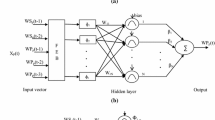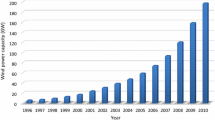Abstract
An accurate short-term wind speed prediction algorithm based on the efficient kernel ridge pseudo inverse neural network (KRPINN) variants is proposed in this paper. The use of nonlinear kernel functions in pseudo inverse neural networks eliminates the trial and error approach of choosing the number of hidden layer neurons and their activation functions. The robustness of the proposed method has been validated in comparison with other models such as pseudo inverse radial basis function (PIRBF) and Legendre tanh activation function based neural network, i.e., PILNNT, whose input weights to the hidden layer weights are optimized using an adaptive firefly algorithm, i.e., FFA. However, since the individual kernel functions based KRPINN may not be able to produce accurate forecasts under chaotically varying wind speed conditions, a linear combination of individual kernel functions is used to build the multi kernel ridge pseudo inverse neural network (MK-RPINN) for providing improved forecasting accuracy, generalization, and stability of the wind speed prediction model. Several case studies have been presented to validate the accuracy of the short-term wind speed prediction models using the real world wind speed data from a wind farm in the Wyoming State of USA over time horizons varying from 10 minutes to 5 hours.
Similar content being viewed by others
Explore related subjects
Discover the latest articles, news and stories from top researchers in related subjects.References
M. Poncela, P. Poncela, J. R. Perán. Automatic tuning of Kalman filters by maximum likelihood methods for wind energy forecasting. Applied Energy, vol. 108, pp. 349–362, 2013.
W. Y. Zhang, J. J. Wang, J. Z. Wang, Z. B. Zhao, M. Tian. Short-term wind speed forecasting based on a hybrid model. Applied Soft Computing, vol. 13 no. 7, pp. 3225–3233, 2013.
B. Candy, S. J. English, S. J. Keogh. A comparison of the impact of QuikScat and WindSat wind vector products on met office analyses and forecasts. IEEE Transactions on Geoscience and Remote Sensing, vol. 47, no. 6, 1632–1640, 2009.
J. L. Torres, A. García, M. De Blas, A. De Francisco. Forecast of hourly average wind speed with ARMA models in Navarre (Spain). Solar Energy, vol. 79, no. 1, pp. 65–77, 2005.
P. Y. Chen, T. Pedersen, B. J. Birgitte, Z. Chen. ARIMAbased time series model of stochastic wind power generation. IEEE Transactions on Power Systems, vol. 25, no. 2, pp. 667–676, 2010.
Z. D. Tian, X. W. Gao, K. Li. A hybrid time-delay prediction method for networked control system. International Journal of Automation and Computing, vol. 11, no. 1, pp. 19–24, 2014.
T. G. Barbounis, J. B. Theocharis, M. C. Alexiadis, P. S. Dokopoulos. Long-term wind speed and power forecasting using local recurrent neural network models. IEEE Transactions on Energy Conversion, vol. 21, no. 1, pp. 273–284, 2006.
S. R. Devi, P. Arulmozhivarman, C. Venkatesh, P. Agarwal. Performance comparison of artificial neural network models for daily rainfall prediction. International Journal of Automation and Computing, vol. 13, no. 5, pp. 417–427, 2016.
Q. H. Hu, S. G. Zhang, Z. X. Xie, J. S. Mi, J. Wan. Noise model based ν-support vector regression with its application to short-term wind speed forecasting. Neural Networks, vol. 57, pp. 1–11, 2014.
Y. Y. Hong, H. L. Chang, C. S. Chiu. Hour-ahead wind power and speed forecasting using simultaneous perturbation stochastic approximation (SPSA) algorithm and neural network with fuzzy inputs. Energy, vol. 35, no. 9, pp. 3870–3876, 2010.
H. Chitsaz, N. Amjady, H. Zareipour. Wind power forecast using wavelet neural network trained by improved Clonal selection algorithm. Energy conversion and Management, vol. 89, pp. 588–598, 2015.
Y. Wang, J. Z. Wang, X. Wei. A hybrid wind speed forecasting model based on phase space reconstruction theory and Markov model: A case study of wind farms in northwest China. Energy, vol. 91, no.C, pp. 556–572, 2015.
H. Liu, C. Chen, H. Q. Tian, Y. F. Li. A hybrid model for wind speed prediction using empirical mode decomposition and artificial neural networks. Renewable Energy, vol. 48, pp. 545–56, 2012.
R. Dash, P. K. Dash. Prediction of financial time series data using hybrid evolutionary Legendre neural network: Evolutionary LENN. International Journal of Applied Evolutionary Computation, vol. 7, no. 1, pp. 16–32, 2016.
J. C. Patra, C. Bornand. Nonlinear dynamic system identification using Legendre neural network. In Proceedings of International Joint Conference on Neural Networks, IEEE, Barcelona, Spain, 2010.
K. Nadhir, D. Chabane, B. Tarek. Firefly algorithm based energy loss minimization approach for optimal sizing & placement of distributed generation. In Proceedings of the 5th International Conference on Modeling, Simulation and Applied Optimization, IEEE, Hammamet, Algeria, 2013.
X. S. Yang, X. S. He. Firefly algorithm: Recent advances and applications. International Journal of Swarm Intelligence, vol. 1, no. 1, pp. 36–50, 2013.
S. M. Ashrafi, A. B. Dariane. Performance evaluation of an improved harmony search algorithm for numerical optimization: Melody Search (MS). Engineering Applications of Artificial Intelligence, vol. 26, no. 4, pp. 1301–1321, 2013.
X. R. Zhou, Z. J. Liu, C. X. Zhu. Online regularized and kernelized extreme learning machines with forgetting mechanism. Mathematical Problems in Engineering, vol. 2014, Article number 938548, 2014.
S. F. Ding, Y. N. Zhang, X. Z. Xu, L. N. Bao. A novel extreme learning machine based on hybrid kernel function. Journal of Computers, vol. 8, no. 8, pp. 2110–2117, 2013.
Z. Ramedani, M. Omid, A. Keyhani, S. Shamshirband, B. Khoshnevisan. Potential of radial basis function based support vector regression for global solar radiation prediction. Renewable and Sustainable Energy Reviews, vol. 39, pp. 1005–1011, 2014.
G. B. Huang, Q. Y. Zhu, C. K. Siew. Extreme learning machine: A new learning scheme of feed forward neural networks. In Proceedings of IEEE International Joint Conference on Neural Networks, IEEE, Budapest, Hungary, vol. 2, pp. 985–990, 2004.
Y. Lan, Y. C. Soh, G. B. Huang. Ensemble of online sequential extreme learning machine. Neurocomputing, vol. 72 no. 13–15, pp. 3391–3395, 2009.
G. B. Huang. An insight into extreme learning machines: Random neurons, random features and kernels. Cognitive Computation, vol. 6, no. 3, pp. 376–390, 2014.
N. Wang, M. J. Er, M. Han. Generalized single-hidden layer feed forward networks for regression problems. IEEE Transactions on Neural Networks and Learning Systems, vol. 26, no. 6, pp. 1161–1176, 2014.
Y. Ren, P. N. Suganthan, N. Srikanth, G. Amaratunga. Random vector functional link network for short-term electricity load demand forecasting. Information Sciences, vol. 367–368, pp. 1078–1093, 2016.
L. Zhang, P. N. Suganthan. A comprehensive evaluation of random vector functional link networks. Information Sciences, vol. 367–368, pp. 1094–1105, 2016.
G. Li, J. Shi. On comparing three artificial neural networks for wind speed forecasting. Applied Energy, vol. 87, no. 7, pp. 2313–2320, 2010.
G. Q. Li, P. F. Niu. An enhanced extreme learning machine based on ridge regression for regression. Neural Computing and Applications, vol. 22, no. 3–4, pp. 803–810, 2013.
M. J. Er, Z. F. Shao, N. Wang. A systematic method to guide the choice of ridge parameter in ridge extreme learning machine. In Proceedings of the 10th IEEE International Conference on Control Automation, IEEE, Hangzhou, China, pp. 852–857, 2013.
S. Arora, S. Singh. A conceptual comparison of firefly algorithm, bat algorithm and cuckoo search. In Proceedings of International Conference on Control Computing Communication & Materials, IEEE, Allahabad, India, pp. 1–4, 2013.
C. Soares, P. B. Brazdil, P. Kuba. A meta-learning method to select the kernel width in support vector regression. Machine Learning, vol. 54, no. 3, pp. 195–209, 2004.
http://wind.nrel.gov/Web nrel/.
Author information
Authors and Affiliations
Corresponding author
Additional information
Recommended by Associate Editor Yi Cao
S. P. Mishra received the B.Tech. and M.Tech. degrees in electrical engineering from the KIIT University, India in 2010 and 2013, respectively. Currently, he is a Ph.D. degree candidate in electrical engineering at Multidisciplinary Research Centre, Sikhsha “O” Anusandhan University, India. He is a member of IEI, SESI and ISTE.
His research interests include renewable energy, artificial intelligence, neural net and control theory.
P. K. Dash received the M.Eng. degree in electrical engineering from Indian Institute of Science, India in 1964, received the Ph.D. degree in electrical engineering from the Sambalpur University, India in 1972, and received the D. Sc. degree in electrical engineering from the Utkal University, India, in 2003. Besides, he had his post-Doctoral education from the University of Calgary, Canada in 1975 and 1976, and he spent more than three decades at the National Institute of Technology, India as a professor and head of the Department of Electrical Engineering. Currently he is working as a director (research and consultancy) at Sikhsha “O” Anusandhan University, India. He had several visiting appointments in Canada, USA, Switzerland, Malaysia and Singapore. He has published more than 600 international journal and conference papers. He is a fellow of Indian National Academy of Engineering, and senior member, IEEE.
His research interests include renewable energy, micro and smart grid, machine intelligence, signal processing and control.
Rights and permissions
About this article
Cite this article
Mishra, S.P., Dash, P.K. Short term wind speed prediction using multiple kernel pseudo inverse neural network. Int. J. Autom. Comput. 15, 66–83 (2018). https://doi.org/10.1007/s11633-017-1086-7
Received:
Accepted:
Published:
Issue Date:
DOI: https://doi.org/10.1007/s11633-017-1086-7




